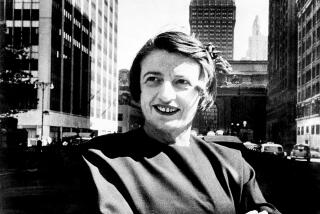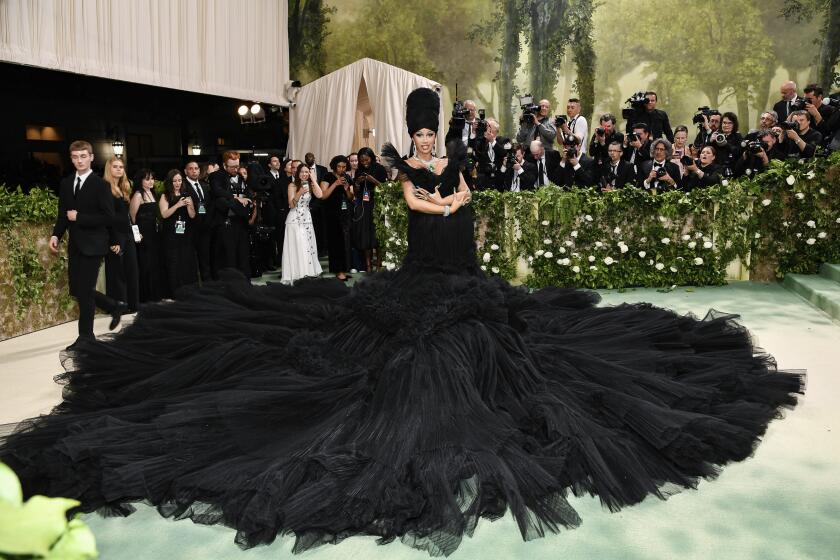A Window on Surfer Dudes of the Past
The faded brown snapshot shows the swaying back of a teenage girl in a two-piece bathing suit, dancing to the music of surfer friends strumming guitars and a ukulele. It’s 1939 on a secluded stretch of beach in San Onofre, and these kids are in paradise.
Don James, the man behind the Kodak, later would become a noted surf photographer. But long before telephoto lenses and the surf wear industry, he documented the high jinks of his pals--oddballs who preferred riding the waves on their homemade, 90-pound boards to playing football.
“Surfing San Onofre to Point Dume, 1936-1942” (Chronicle Books, 140 pages, $24.95) conjures up a vanished Eden of handsome young men squinting into the sun as they surfed, picnicked, camped and shot the breeze with carefree girlfriends on pristine beaches. Shortly before his death in 1998, James recounted brief anecdotes about the images to essayist C.R. Stecyk. Included here, they evoke a motley cast of daredevils and slackers like George “Peanuts” Larson, who wears crumpled shorts, a fringe of beard and an expression of goofy bonhomie after sleeping on the beach for a month without a bath.
*
Long pigeonholed as a designer for budget-minded housewives (her wildly popular “Pop-over”dress sold for as little as $6.99), Claire McCardell actually was a major innovator in the 1940s and ‘50s. Whether turning ballet slippers into street wear (to get around wartime leather rationing) or finding body-defining uses for early stretch fabrics, she came up with witty solutions to practical problems.
Kohle Yohannan, a design historian, and archivist Nancy Nolf introduce this little-known American designer in “Claire McCardell: Redefining Modernism” (Abrams, 151 pages, $39.95), illustrated largely with vintage magazine photos.
Intrigued since her childhood by the engineering of garments, McCardell often spent her student days in New York pulling apart castoff Paris originals and sewing them back together with her own stylistic touches. In an era of fussy, impractical clothes, McCardell--a skier and outdoorswoman who loved menswear--incorporated big side pockets into which a woman could comfortably dig her hands, deeper armholes and practical cottons into her designs.
Her playfully forward-looking styles from the ‘50s included fake fur accessories, leotards, a short leather skirt and brilliantly simple dresses that got their shapes from ultra-wide belts or an ingenious system of skinny, body-wrapping ties. Fortunately, she had the drive to get her styles into production, often over the strenuous objections of her bosses. Sadly, she died of cancer in 1958 at the height of her success.
*
French designer Pierre Chareau was 48 when he got his 15 minutes--a storm of publicity in 1932 for his revolutionary Glass House (Maison de Verre), sheathed in translucent glass bricks that let in copious amounts of natural light yet preserved privacy.
The clients, a doctor and his wife--friends of Chareau’s wife--had wanted to turn an 18th century Parisian building into a combination home and office. Chareau came up with all kinds of innovative yet practical designs, from a mechanical system that pumped air through ducts in the floors (compensating for the lack of windows that opened) to a bathtub unit that also served as a bookshelf.
“Pierre Chareau: Designer and Architect” (Taschen, 160 pages, $24.99) introduces the ingenious and handsome work of this little-known Modernist figure. A superb designer of elegantly simple wood and metal furniture, Chareau was a theater buff and sometime film-set designer with ties to avant-garde Parisian artists and writers. Intrigued by the range and grace of human movement, he often designed objects that swiveled, pivoted, rolled or slid to accommodate storage or privacy requirements. He paid special attention to the way a piece of furniture touched the floor, often using ball-shaped feet.
Typical of Chareau’s poetic treatment of ordinary objects is a floor lamp with a serene cluster of wimple-like triangular pieces of alabaster at the top of an elongated triangular column. Exhibited in 1924, it quickly acquired a nickname: “the Nun.”
*
In the 1950s, when Lee Friedlander began working for Atlantic Records as house photographer, the label boasted the likes of Charles Mingus and Ray Charles, the Drifters and the Coasters. Friedlander also roamed the country, photographing marching bands in New Orleans and blues musicians in the Delta, bluegrass players and gospel singers, jazz artists and rhythm-and-blues folks.
“American Musicians” (Distributed Art Publishers Inc., 272 pages, $49.95) is an extraordinary volume of some 200 of Friedlander’s intimate, emotional images of famous and unknown American musicians from the past 40 years.
Watching Aretha Franklin’s mouth push out the lyrics of her songs in a series of close-ups from 1967 is absolutely mesmerizing. Pages and pages of black-and-white images of the intense faces of sax players--John Coltrane, Stan Getz, Ornette Coleman and many others--evoke the visceral feeling of listening to rapturous swells of sound.
Friedlander also has a brightly tacky ‘70s color style (Tammy Wynette, posed in a red outfit and red plastic boots in a forest) and a hugely sympathetic eye for musicians whose names are never on marquees. A blind man--white cane hooked over his shoulder--strums his guitar in a vacant lot in Nashville. A neatly dressed family sings gospel raptly in the doorway of a room where defeated-looking people sag on a tumbledown couch. You can practically hear the air vibrate.
More to Read
Sign up for our Book Club newsletter
Get the latest news, events and more from the Los Angeles Times Book Club, and help us get L.A. reading and talking.
You may occasionally receive promotional content from the Los Angeles Times.






